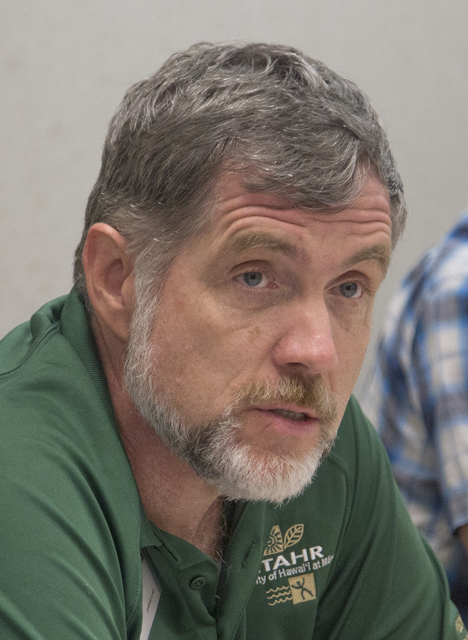Rallying for ohia; State summit brings stakeholders together to fight tree disease
After more than a year of emergency response efforts, collaborators working to stop the spread of rapid ohia death are shifting to a long-term research and management strategy.
ADVERTISING
The new response plan was presented during the first-ever rapid ohia death summit Wednesday in Honolulu, which was attended by researchers, scientists, politicians, state officials, students and concerned residents alike.
About 200 people participated, more than double what organizers initially expected.
The summit also featured an extensive recap of the ongoing efforts to study, contain and manage the disease that has devastated thousands of acres of native forest on the Big Island. So far, it has not spread to other islands.
“Ohia’s form, function and abundance make these trees the most important watershed tree (in Hawaii),” said Gov. David Ige, who provided opening remarks. “The time to act is now. I look forward to the work that will happen here today and in the weeks and months to come.”
Last month, the first case of rapid ohia death on the Hamakua Coast was confirmed after a large tree in Laupahoehoe died from the disease. The first confirmed cases were in the Puna area.
Rapid ohia death is caused by a fungus that affects the xylem systems circulating water through the tree. But that wasn’t known when property owners first started reporting that their ohia was dying off.
“This is not like dengue,” said J.B. Friday, extension forester with the University of Hawaii’s College of Tropical Agriculture and Human Resources. “When dengue came here, it was a big thing, but we knew what dengue was. We did not know what this was.”
“In order to know if it’s a new disease, you have to know what is normal in the plant,” said U.S. Department of Agriculture plant pathologist Lisa Keith. Keith and her lab have been researching causes and effects of rapid ohia death outbreaks to determine better intervention strategies.
They isolated and identified two separate species of the Ceratocystis fungus.
“They’re currently being described and renamed,” Keith said. “Nowhere else in the world is there an exact match.”
During the past 2 1/2 years, the lab has sampled more than 830 trees for rapid ohia death.
The lab also is working to figure out what plant brought the fungus to Hawaii and whether ohia hosts can develop tolerance or resistance to the disease.
Some research efforts focus specifically on the spread of the disease, as with Gordon Bennett’s work for CTAHR. Bennett and his team study wood-boring beetles, which burrow into trees to live and breed.
The beetles create tiny particles of dust (frass) when they make their burrows. If they burrow into an infected tree, the beetles themselves could carry fungi spores on their exoskeletons. The frass also could carry spores.
“It’s not only there and abundant, but it’s potentially viable,” Bennett said. “How far can the boring dust go on the wind?”
Adding to the snapshots created through aerial surveying and mapping, a more exact picture of how rapid ohia death has spread around the island will be ready next year.
In January, Stanford University’s Carnegie Airborne Observatory is expected to have a complete three-dimensional map of the Big Island’s forests finished. The last full map was made in 2007.
“We’re going to get a good net sense of change,” said observatory principal investigator Greg Asner.
The emergency response to rapid ohia death has been notably faster than other responses to invasive species. An emergency quarantine on transporting ohia and ohia plant parts from the Big Island was put in place last summer by the state Department of Agriculture. That quarantine was made permanent this fall.
“Quick action was so critical,” said Flint Hughes of the U.S. Forest Service Institute of Pacific Islands Forestry. “We didn’t have to begin controlling or managing diseases on the other islands, and we’re all crossing our fingers that the Ceratocystis-free status will (continue) on other islands.”
Rob Hauff, a forester with the state Department of Land and Natural Resources Division of Forestry and Wildlife, presented the strategic response plan developed by members of a rapid ohia death working group that meets monthly.
The three-year plan presented budget needs for addressing seven objectives, that ranged from ramping up community outreach efforts to creating a “sustainable, coordinated and efficient response” to new outbreaks.
“The goal is really to provide a road map for what the situation is and where we need to go,” Hauff said.
To date, research, management and outreach efforts have totaled more than $2.3 million. Funding has come from federal, state, county and private sources, which include foundations, individuals and crowdsourcing efforts.
Estimates for implementing the first year of strategic response total about $3.6 million. The three-year total is about $10 million.
Specific response plans still need to be developed in areas such as seed collection and forest restoration.
To view the new strategic response plan, visit www.rapidohiadeath.org.
Email Ivy Ashe at iashe@hawaiitribune-herald.com.







